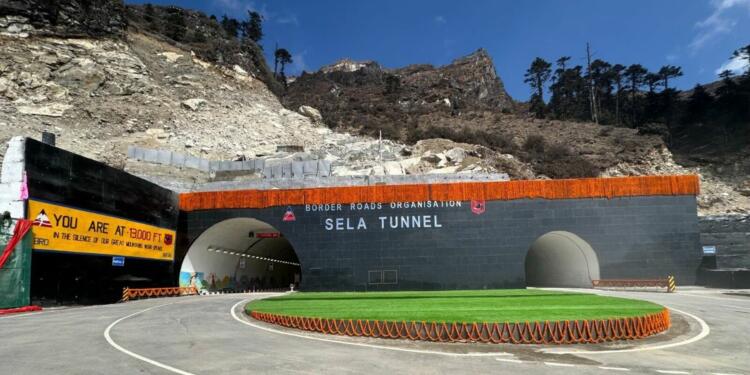The recent inauguration of the Sela Tunnel by Prime Minister Narendra Modi marks a significant milestone in India’s strategic infrastructure development in Arunachal Pradesh. This tunnel holds paramount importance for the Indian Army, offering year-round connectivity and operational advantages in the region. Constructed as the world’s longest twin-tube tunnel, cutting through the Sela-Charbela ridge, its completion is a cause of concern for China, as it enhances India’s military readiness along the sensitive India-China border.
Arunachal’s Connectivity Challenges
In the rugged terrain of Arunachal Pradesh, maintaining connectivity between Guwahati and Tawang has long been a daunting task plagued by various natural obstacles. Historically, the region has faced severe challenges due to harsh weather conditions, heavy snowfall during winter months, and frequent landslides, particularly in the Sela Pass area. These challenges have not only hindered civilian transportation but also posed significant obstacles to the movement of military personnel and supplies, thereby impacting strategic readiness along the border.
Harsh Weather Conditions
Arunachal Pradesh, with its high altitude and rugged terrain, experiences extreme weather conditions, especially during winter. The Sela Pass, standing at an elevation of 13,700 feet, is particularly susceptible to heavy snowfall and blizzards, making it impassable for extended periods. The closure of this crucial route due to inclement weather severely affects the connectivity between Guwahati and Tawang, disrupting both civilian and military movements.
Heavy Snowfall
The region’s mountainous topography exacerbates the impact of heavy snowfall, leading to the accumulation of thick layers of snow on roads and mountain passes. This snow accumulation makes road travel treacherous and often requires extensive snow-clearing operations to ensure safe passage. However, the frequency and intensity of snowfall make it challenging to maintain continuous connectivity throughout the winter months.
Frequent Landslides
Arunachal Pradesh is prone to frequent landslides, especially during the monsoon season, due to its steep slopes and unstable geological formations. These landslides can block roads and disrupt traffic flow, causing delays and logistical challenges for both civilian and military convoys. The unpredictable nature of landslides further complicates efforts to ensure reliable connectivity in the region.
The Sela Tunnel
The construction of the Sela Tunnel, along with the Nechiphu Tunnel, represents a significant step towards addressing these longstanding connectivity challenges in Arunachal Pradesh.
All-Weather Connectivity
By bypassing the treacherous Sela Pass, the Sela Tunnel provides a reliable, all-weather alternative route between Guwahati and Tawang. Unlike the surface road that is vulnerable to weather-related disruptions, the tunnel offers uninterrupted connectivity throughout the year, ensuring the smooth movement of both civilian and military traffic.
Reduction in Travel Time
The Sela Tunnel significantly reduces travel time between Guwahati and Tawang, offering a more efficient and time-saving route for commuters and logistics operations. With the elimination of delays caused by snow clearance and landslides, the tunnel facilitates faster and more reliable transportation of personnel, supplies, and equipment, enhancing overall operational efficiency.
Enhanced Military Mobility
From a military perspective, the Sela Tunnel and Nechiphu Tunnel play a crucial role in improving the mobility of Indian Army units deployed in Arunachal Pradesh. The tunnels enable swift deployment of troops and equipment to remote border areas, enhancing defensive capabilities and response readiness along the sensitive India-China border. Moreover, the tunnels reduce the vulnerability of military convoys to enemy observation and attacks, ensuring greater security and operational flexibility.
Also Read: Agni-V: India’s Firestarter or China’s Sleepless Nights?
Countering Chinese Advantages
The strategic advantage provided by the Sela Tunnel to Indian forces lies in its ability to facilitate the movement of equipment and troops without being detected by the Chinese. This clandestine mobility serves as a crucial countermeasure against Chinese surveillance and reconnaissance efforts along the sensitive India-China border in Arunachal Pradesh.
Undetected Troop Movements
The construction of the Sela Tunnel allows Indian forces to bypass the traditional surface routes, such as the Sela Pass, which are susceptible to Chinese observation. By utilizing the tunnel, troop movements can occur covertly, hidden from prying eyes and satellite surveillance. This clandestine mobility denies the Chinese crucial intelligence regarding the timing, size, and direction of Indian military deployments, thereby enhancing operational security and maintaining a strategic advantage.
Preservation of Surprise Factor
The element of surprise is a critical component of military strategy, enabling commanders to achieve tactical objectives with minimal resistance and maximum impact. By nullifying Chinese visibility over troop movements on the Sela Pass, the Sela Tunnel preserves the element of surprise for Indian military operations in the region. Whether it’s reinforcement of border defenses, conduct of reconnaissance missions, or initiation of offensive actions, the ability to move troops undetected enhances the effectiveness and success of Indian military maneuvers.
Enhanced Operational Flexibility
The Sela Tunnel not only conceals troop movements but also provides Indian forces with greater operational flexibility along the India-China border. With the ability to deploy and redeploy troops rapidly and discreetly, military commanders can respond swiftly to evolving threats, exploit enemy vulnerabilities, and seize strategic opportunities. This enhanced agility and adaptability bolster India’s deterrence posture vis-à-vis China and contribute to the overall stability and security of the region.
Reduced Vulnerability to Preemptive Strikes
By utilizing the Sela Tunnel, Indian forces mitigate the risk of preemptive strikes by the Chinese aimed at disrupting or interdicting troop movements along vulnerable surface routes. The tunnel’s subterranean nature offers protection against aerial surveillance, missile attacks, and artillery bombardment, thereby reducing the vulnerability of Indian military assets to enemy aggression. This defensive advantage strengthens India’s ability to withstand Chinese coercion and maintain territorial integrity along the border.
Infrastructure Development as Defense Strategy
Infrastructure development in Arunachal Pradesh, including projects like the Frontier Highway and the Trans-Arunachal Highway, plays a pivotal role in bolstering India’s defense capabilities and strategic posture along the India-China border. These projects are not merely civilian infrastructure initiatives but are intricately linked to national security considerations, aimed at enhancing troop mobility, logistical support, and operational readiness in the region.
Frontier Highway and Trans-Arunachal Highway
The Frontier Highway is a proposed 1,700 km long highway connecting all frontier districts and sites along the breadth of Arunachal Pradesh. Similarly, the Trans-Arunachal Highway is a significant road network project aimed at connecting various regions within the state. These highways are designed to improve connectivity, facilitate economic development, and promote tourism in the region. However, their strategic significance extends far beyond civilian benefits.
Also Read: Jaishankar’s Sharp Wit: China’s Intentions Under Scrutiny
Strengthening Defense Capabilities
The construction of highways in Arunachal Pradesh strengthens India’s defense capabilities by improving access to remote border areas, enhancing logistical support for military operations, and facilitating rapid troop deployment in case of contingencies. These highways provide vital arteries for the movement of troops, equipment, and supplies, thereby enhancing India’s ability to respond effectively to security challenges along the border.
Matching Chinese Infrastructure
China has invested heavily in infrastructure development along its side of the border with Arunachal Pradesh, including roads, railways, and airfields. India’s infrastructure projects in the region are aimed at matching and, in some cases, surpassing Chinese infrastructure capabilities. This strategic parity is essential for maintaining a balance of power along the disputed border and deterring potential aggression from China.
Enhancing Troop Mobility
Improved road connectivity through projects like the Frontier Highway and Trans-Arunachal Highway enhances troop mobility, allowing Indian forces to swiftly deploy reinforcements, conduct patrols, and fortify border defenses as needed. This increased mobility not only strengthens India’s defensive posture but also serves as a deterrent against external threats by showcasing India’s ability to quickly reinforce its border positions.
Facilitating Border Management
In addition to military considerations, infrastructure development in Arunachal Pradesh also facilitates better border management and governance. Accessible roads enable government agencies to assert territorial control, monitor cross-border activities, and provide essential services to remote border communities. This integrated approach to border management contributes to overall stability and security in the region.
In conclusion, The strategic significance of the Sela Tunnel and infrastructure projects in Arunachal Pradesh lies in their ability to enhance troop mobility, ensure all-weather connectivity, and counter Chinese advantages along the India-China border. These developments bolster India’s defense posture by providing covert troop movements, matching Chinese infrastructure, and facilitating rapid deployment in remote border areas. Ultimately, they safeguard India’s territorial integrity, strengthen deterrence against aggression, and promote stability amidst evolving geopolitical challenges, reaffirming India’s commitment to defending its borders and promoting regional security.
Also Read; The Great AI Breach: Google, China, and the Stolen Secrets





























